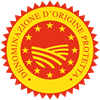Description
Castelmagno PDO is a semi-hard cheese produced with raw whole cow’s milk from cows fed on fresh or dry fodder from the production area, with a small amount of semi-skimmed sheep or goat’s milk (5-20%).
Production Area
The production area of Castelmagno PDO is within the municipalities of Castelmagno, Pradleves and Monterosso Grana in the Province of Cuneo, in the Piedmont region.
Production Method
The cattle breeds used for the production of the milk must be retraceable to the Barà Pustertaler, Bruna, Pezzata Rossa d’Oropa, Pezzata Rossa, Montbeillard, Grigio Alpina, Piemontese and Valdostana breeds or their cross-breeds. The milk is brought to 30-38 °C and then curdled with liquid calf rennet. The curd is broken, left to settle and then to rest for at least 18 hours. It is then transferred to special recipients and immersed in the whey obtained from the previous process, and left for 2-4 days to complete the fermentation. The curd is then broken again, finely chopped, remixed and salted before being wrapped in a cloth and put in moulds for at least one day, where the wheels are pressed either by hand or mechanically. Further dry-salting of the dry wheels is permitted. Ripening must take place in a cool, humid environment for at least 60 days, as specified in the product specification. They are left to ripen on wooden shelves and are washed and turned regularly. Castelmagno PDO can display the words “Prodotto della Montagna” (Mountain Product) if the cheese is obtained from cows that are pasture-grazed at an altitude of between 650 and 1000 m.a.s.l.; if at least 90% of the cattle’s diet is made up of pasture eaten at an altitude of above 1000 metres, only in the Summer, the label can indicate “Di Alpeggio” (Alpine).
Appearance and Flavour
Castelmagno PDO has a cylindrical shape, with a diameter of 15-25 cm, a heel height of 12-20 cm and a weight of between 2 and 7 kg. The rind of the fresh cheese is thin and smooth with a reddish-yellow colour, and tends to be wrinklier in the more mature cheese. The cheese is very crumbly and without eyes, ranging from ivory white to yellow-ochre, with bluish-green veins (marbling) in the more mature cheese. If only slightly ripened, the flavour is delicate, while the mature variety is flavoursome and piquant.
History
According to tradition, Castelmagno PDO, invented thanks to the creativity of shepherds in Alta Valle Grana, has ancient origins: the very first versions were being produced as early as the 12th century. This cheese has been rediscovered at both national and international level, thanks to the rationalisation and standardisation of the artisan production techniques.
Gastronomy
Castelmagno PDO should be kept in a cool environment or in the refrigerator, wrapped in its original packaging. It is eaten as a table cheese or used as an ingredient in many recipes. It is ideal for using in pasta, rice, polenta and gnocchi dishes, but also to serve with beef Carpaccio. It is also goes well with honey or jam, and it pairs perfectly with full-bodied red wines.
Marketing
The product is marketed as Castelmagno PDO, with the possible addition of “Prodotto della Montagna” or “Di Alpeggio”. It is sold whole, in pieces, and in pre-packed slices. The product logo is embossed on the top of the wheel when it comes into contact with the base of the mould during the shaping process.
Distinctive Features
The erborinatura (marbling), a term derived from the Lombard dialect word erborin, meaning parsley, develops naturally in Castelmagno PDO cheese during the ripening process, without the need to inoculate the cheese with specific moulds.

















